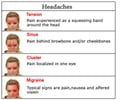Researchers found that a novel therapy using a miniature nerve stimulator instead of the medication for the treatment of profoundly disabling headache disorders relieved pain by 80-95 percent.
Researchers found that a novel therapy using a miniature nerve stimulator instead of the medication for the treatment of profoundly disabling headache disorders relieved pain by 80-95 percent.
The findings, by researchers from the University of California, San Francisco and the National Hospital for Neurology and Neurosurgery in London, give doctors the promise of a non-drug treatment option for pain sufferers unable to tolerate indometacin - the standard medication known to cause stomach bleeding in some patients.The device, called a bion, is a rechargeable battery-powered electrode, similar in size to a matchstick. When implanted near the occipital nerve in the back of the neck, it eases pain by generating pulses that the nerve receives. The bion can be turned on or off via an external wireless remote control.
For the study, the researchers measured the effectiveness of nerve stimulation in six patients aged 37 to 64 with hemicrania continua -a rare headache disorder defined by the International Headache Society as a form of chronic daily headache in which patients have 15 days or more of headache per month.
In the beginning of the study, participants underwent a minimally invasive surgery to have the bion implanted at the occipital nerve. Each participant then received continuous stimulation of the nerve for the first three months.
The device was switched off for the fourth month, ensuring that patients did not receive stimulation of the occipital nerve during that time, and switched on again at month five.
Switching off the bion allowed researchers to measure whether the device, rather than the placebo affect, was responsible for pain modulation.
Advertisement
Patients kept diaries, at hourly intervals during waking hours, which included a pain severity scale ranging from 1 to 10 points. Participants shared their diaries with researchers after the fifth month.
Advertisement
At long-term follow-up, four of the six patients reported substantial pain improvement at a level of 80 to 95 percent, one patient saw a 30 percent improvement, and one patient reported that his pain worsened by 20 percent.
Overall, the researchers found that participants not only improved with the bion therapy, but their pain worsened when the bion was switched off during the fourth month.
Also, diary submissions revealed an overall reduction in the pain score of five to eight points.
The findings appear in the November 2008 issue of Lancet Neurology.
Source-ANI
RAS/SK













